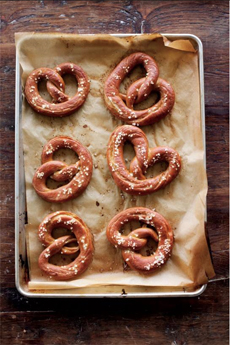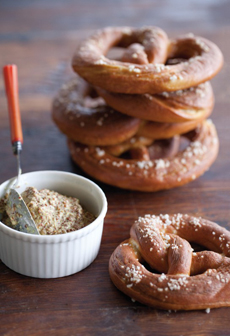RECIPE: Homemade Soft Pretzels
 Bake a batch for National Pretzel Day. Photo courtesy Williams-Sonoma. |
April 26th is National Pretzel Day. Bake a batch of delicious soft pretzels and serve with grainy mustard and beer.
This recipe is courtesy Williams-Sonoma. See more photos of the process. Find more delicious recipes at WilliamsSonoma.com. Ingredients For 12 Large Pretzels |
|
|
Preparation 1. STIR together in the bowl of a stand mixer the warm water, yeast and sugar. Let stand until foamy, about 10 minutes. 2. ADD the olive oil, flour and salt. Attach the dough hook and knead the dough on medium-low speed until smooth, about 10 minutes. Form the dough into a ball, cover the bowl with plastic wrap, and let rise in a warm, draft-free spot until doubled, about 1 hour. |
||
|
3. PREHEAT the oven to 450°F with the rack placed in the middle. Line 2 baking sheets with parchment paper and brush the parchment with oil. Place the dough on a lightly floured work surface, then cut it into 12 equal pieces. Roll each piece into a long rope about 18 inches long. Position each rope positioned horizontally. 4. BRING the 2 ends of the rope up and toward the center as if forming an oval. Cross one end over the other, and press each end into the bottom of the oval to create a pretzel shape. Place the pretzels on the prepared pan. 5. FILL a large, wide saucepan with 7 cups of water. Stir in the baking soda, and bring to a boil. Gently drop 2 or 3 pretzels at a time into the boiling water (be careful not to overcrowd them). Boil for just under 1 minute, turning once with a large slotted spoon or spatula. Return the boiled pretzels to the baking sheet, spacing them evenly, top side up. 6. SPRINKLE the pretzels with coarse salt. Bake until beautifully browned, about 10 minutes, rotating the pans about halfway through. Serve warm with big spoonfuls of grainy mustard. |
||
|
GRAINY MUSTARD & MUSTARD HISTORY The origins of mustard are lost to history, but it is a Northern Hemisphere plant, the seeds of which have been found in Stone Age settlements. Our word mustard comes from the Middle English mustarde, meaning condiment; which in turn comes from the Old French mostarde. Mosto derives from the Latin mustum, the word for grape must, or young, unfermented wine, which was the liquid mixed with ground mustard seed by French monks who made the condiment. The monks’ word for mustard was mustum ardens, meaning burning wine. By the 1400s, mustard-making had spread through Europe; each region made its own style. One of the earliest versions was grainy mustard, a more casual name for what is known as old-style or old-fashioned mustard, and moutarde à l’ancienne in French. Grainy mustard is prepared from a base of mixed mustard seeds, verjus or white wine, spices and herbs. The ingredients are ground coarsely in order to leave the seeds whole. Grainy mustard has a dark color and a slightly milder flavor than other mustards. It has a slightly sweet taste, making it a good accompaniment for rustic foods like sausages or country-style pates and cornichons. It can be mixed with melted garlic butter and fresh thyme to create a sauce to drizzle over fish, and many other creative preparations. Here’s more on the history of mustard and the different types of mustard.
|
||



